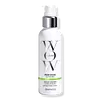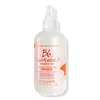What's inside
What's inside
 Key Ingredients
Key Ingredients

No key ingredients
 Benefits
Benefits

 Concerns
Concerns

 Ingredients Side-by-side
Ingredients Side-by-side

Water
Skin ConditioningBehentrimonium Methosulfate
Cetyl Alcohol
EmollientCaprylic/Capric Triglyceride
MaskingPolyquaternium-37
Glycerin
HumectantButylene Glycol
HumectantPhenoxyethanol
PreservativeSilicone Quaternium-18
EmollientPropylene Glycol Dicaprylate/Dicaprate
EmollientCaprylyl Glycol
EmollientCeteareth-20
CleansingPPG-26-Buteth-26
Skin ConditioningPEG-40 Hydrogenated Castor Oil
EmulsifyingParfum
MaskingTrideceth-6
EmulsifyingPPG-1 Trideceth-6
Skin ConditioningTrideceth-12
EmulsifyingCrambe Maritima Leaf Extract
Skin ConditioningAscophyllum Nodosum Extract
Skin ConditioningBenzyl Salicylate
PerfumingLinalool
PerfumingLimonene
PerfumingWater, Behentrimonium Methosulfate, Cetyl Alcohol, Caprylic/Capric Triglyceride, Polyquaternium-37, Glycerin, Butylene Glycol, Phenoxyethanol, Silicone Quaternium-18, Propylene Glycol Dicaprylate/Dicaprate, Caprylyl Glycol, Ceteareth-20, PPG-26-Buteth-26, PEG-40 Hydrogenated Castor Oil, Parfum, Trideceth-6, PPG-1 Trideceth-6, Trideceth-12, Crambe Maritima Leaf Extract, Ascophyllum Nodosum Extract, Benzyl Salicylate, Linalool, Limonene
Water
Skin ConditioningCetearyl Alcohol
EmollientButylene Glycol
HumectantPEG-12 Glyceryl Dimyristate
Skin ConditioningVitis Vinifera Seed Oil
EmollientPrunus Amygdalus Dulcis Oil
Skin ConditioningMacadamia Integrifolia Seed Oil
Skin ConditioningCocos Nucifera Oil
MaskingGardenia Taitensis Flower Extract
Skin ConditioningArgania Spinosa Kernel Oil
EmollientCarthamus Tinctorius Seed Oil
MaskingHydroxypropyltrimonium Hydrolyzed Corn Starch
Hydrolyzed Vegetable Protein Pg-Propyl Silanetriol
Skin ConditioningHydrolyzed Wheat Protein Pg-Propyl Silanetriol
Skin ConditioningDimethicone
EmollientGlycerin
HumectantSodium Hyaluronate
HumectantBehentrimonium Methosulfate
Distearyldimonium Chloride
Dimethiconol
EmollientCetrimonium Chloride
AntimicrobialButyl Methoxydibenzoylmethane
UV AbsorberEthylhexyl Methoxycinnamate
UV AbsorberSodium Chloride
MaskingCitric Acid
BufferingBHT
AntioxidantParfum
MaskingHexyl Cinnamal
PerfumingLinalool
PerfumingLimonene
PerfumingPotassium Sorbate
PreservativePhenoxyethanol
PreservativeWater, Cetearyl Alcohol, Butylene Glycol, PEG-12 Glyceryl Dimyristate, Vitis Vinifera Seed Oil, Prunus Amygdalus Dulcis Oil, Macadamia Integrifolia Seed Oil, Cocos Nucifera Oil, Gardenia Taitensis Flower Extract, Argania Spinosa Kernel Oil, Carthamus Tinctorius Seed Oil, Hydroxypropyltrimonium Hydrolyzed Corn Starch, Hydrolyzed Vegetable Protein Pg-Propyl Silanetriol, Hydrolyzed Wheat Protein Pg-Propyl Silanetriol, Dimethicone, Glycerin, Sodium Hyaluronate, Behentrimonium Methosulfate, Distearyldimonium Chloride, Dimethiconol, Cetrimonium Chloride, Butyl Methoxydibenzoylmethane, Ethylhexyl Methoxycinnamate, Sodium Chloride, Citric Acid, BHT, Parfum, Hexyl Cinnamal, Linalool, Limonene, Potassium Sorbate, Phenoxyethanol
 Reviews
Reviews

Ingredients Explained
These ingredients are found in both products.
Ingredients higher up in an ingredient list are typically present in a larger amount.
Behentrimonium Methosulfate is an ammonium salt. It is mainly used to prevent static in haircare products as a surfactant.
Surfactants have differing ends: one side is hydrophilic while the other end is hydrophobic.
Surfactants also help your cleansers remove pollutants more easily from the skin.
Learn more about Behentrimonium MethosulfateButylene Glycol (or BG) is used within cosmetic products for a few different reasons:
Overall, Butylene Glycol is a safe and well-rounded ingredient that works well with other ingredients.
Though this ingredient works well with most skin types, some people with sensitive skin may experience a reaction such as allergic rashes, closed comedones, or itchiness.
Learn more about Butylene GlycolGlycerin is already naturally found in your skin. It helps moisturize and protect your skin.
A study from 2016 found glycerin to be more effective as a humectant than AHAs and hyaluronic acid.
As a humectant, it helps the skin stay hydrated by pulling moisture to your skin. The low molecular weight of glycerin allows it to pull moisture into the deeper layers of your skin.
Hydrated skin improves your skin barrier; Your skin barrier helps protect against irritants and bacteria.
Glycerin has also been found to have antimicrobial and antiviral properties. Due to these properties, glycerin is often used in wound and burn treatments.
In cosmetics, glycerin is usually derived from plants such as soybean or palm. However, it can also be sourced from animals, such as tallow or animal fat.
This ingredient is organic, colorless, odorless, and non-toxic.
Glycerin is the name for this ingredient in American English. British English uses Glycerol/Glycerine.
Learn more about GlycerinLimonene is a fragrance that adds scent and taste to a formulation.
It's found in the peel oil of citrus fruits and other plants such as lavender and eucalyptus. The scent of limonene is generally described as "sweet citrus".
Limonene acts as an antioxidant, meaning it helps neutralize free radicals.
When exposed to air, oxidized limonene may sensitize the skin. Because of this, limonene is often avoided by people with sensitive skin.
The term 'fragrance' is not regulated in many countries. In many cases, it is up to the brand to define this term. For instance, many brands choose to label themselves as "fragrance-free" because they are not using synthetic fragrances. However, their products may still contain ingredients such as essential oils that are considered a fragrance.
Learn more about LimoneneLinalool is a fragrance and helps add scent to products. It's derived from common plants such as cinnamon, mint, citrus, and lavender.
Like Limonene, this ingredient oxidizes when exposed to air. Oxidized linalool can cause allergies and skin sensitivity.
This ingredient has a scent that is floral, spicy tropical, and citrus-like.
Learn more about LinaloolParfum is a catch-all term for an ingredient or more that is used to give a scent to products.
Also called "fragrance", this ingredient can be a blend of hundreds of chemicals or plant oils. This means every product with "fragrance" or "parfum" in the ingredients list is a different mixture.
For instance, Habanolide is a proprietary trade name for a specific aroma chemical. When used as a fragrance ingredient in cosmetics, most aroma chemicals fall under the broad labeling category of “FRAGRANCE” or “PARFUM” according to EU and US regulations.
The term 'parfum' or 'fragrance' is not regulated in many countries. In many cases, it is up to the brand to define this term.
For instance, many brands choose to label themselves as "fragrance-free" because they are not using synthetic fragrances. However, their products may still contain ingredients such as essential oils that are considered a fragrance by INCI standards.
One example is Calendula flower extract. Calendula is an essential oil that still imparts a scent or 'fragrance'.
Depending on the blend, the ingredients in the mixture can cause allergies and sensitivities on the skin. Some ingredients that are known EU allergens include linalool and citronellol.
Parfum can also be used to mask or cover an unpleasant scent.
The bottom line is: not all fragrances/parfum/ingredients are created equally. If you are worried about fragrances, we recommend taking a closer look at an ingredient. And of course, we always recommend speaking with a professional.
Learn more about ParfumPhenoxyethanol is a preservative that has germicide, antimicrobial, and aromatic properties. Studies show that phenoxyethanol can prevent microbial growth. By itself, it has a scent that is similar to that of a rose.
It's often used in formulations along with Caprylyl Glycol to preserve the shelf life of products.
Water. It's the most common cosmetic ingredient of all. You'll usually see it at the top of ingredient lists, meaning that it makes up the largest part of the product.
So why is it so popular? Water most often acts as a solvent - this means that it helps dissolve other ingredients into the formulation.
You'll also recognize water as that liquid we all need to stay alive. If you see this, drink a glass of water. Stay hydrated!
Learn more about Water